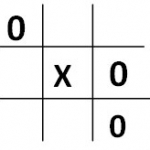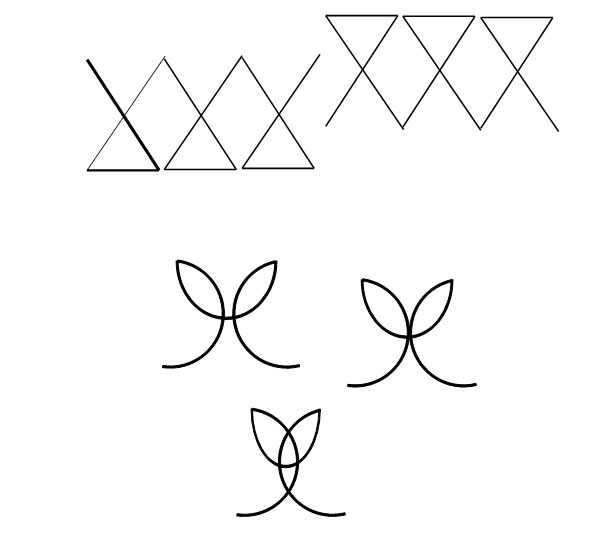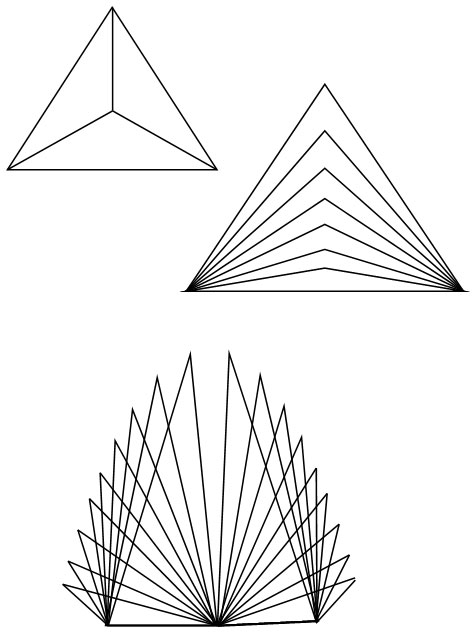
Key words for rhyming phrase three trees I can see three bees in three trees
Number Rhyme
I saw three trees growing so high and tall.
I counted two thick tree trunks waiting in a stack.
I planted a sapling beside the sparkling stream,
In three years time I wonder how thick and tall it will be.
Numbers are easily reversed during early learning. Sparklers can be bought in the shape  of each number. When a child is viewing the sparkler from a position directly in front, this can provide a spectacular and memorable experience that establishes a clear identity of the correct orientation of each number shape. When lit at the top a number shaped sparkler will burn in the same direction as the number is written. All numbers are normally written from the top. All written and concrete number shapes can be given a green coloured dot at the top on the correct side of the shape so that there is a clue to where the number starts when it is written and a way of establishing the correct orientation.
of each number. When a child is viewing the sparkler from a position directly in front, this can provide a spectacular and memorable experience that establishes a clear identity of the correct orientation of each number shape. When lit at the top a number shaped sparkler will burn in the same direction as the number is written. All numbers are normally written from the top. All written and concrete number shapes can be given a green coloured dot at the top on the correct side of the shape so that there is a clue to where the number starts when it is written and a way of establishing the correct orientation.  The author has also drawn a black line or edge to indicate where the number would sit on base line.
The author has also drawn a black line or edge to indicate where the number would sit on base line.
Activity and art
- Make a wall picture of the above rhyme
- Using the thumb and first two fingers of the right hand make a print with the finger tips while holding the fingers in a vertical line. E.g. then pull the fingers across the paper towards the little finger [to the right]
Use this colour coded print as a guide for the production of a written number three:-
- Bark and Leaf rubbings and prints from three different trees.
- Find a clover leaf and draw it.
- I/we have made 33 bees. Place ten bees on one honeycomb tray and then another ten on the next honeycomb tray and finally the last batch of ten on a third tray and place the remaining odd three bees flying somewhere nearby. Young children may not understand this creative presentation of the base ten system, but later when they gain more understanding they can relate back to their memory of the thirty three bees project. Similarly the visual relationship between a 3 and the B capital may not be consciously discovered until later. It is helpful to the young child’s multisensory discovery-learning that these details are left undiscovered. If specifically taught as important information during the initial learning stages the value of self discovery is permanently lost.
- 3D Shape
 The cylinder is a three sided shape that can be explored as a theme, e.g. matching or grading cylindrical shapes according to height and diameter. Making a kaleidoscope. Building a tower using cylinder shaped wooden bricks.
The cylinder is a three sided shape that can be explored as a theme, e.g. matching or grading cylindrical shapes according to height and diameter. Making a kaleidoscope. Building a tower using cylinder shaped wooden bricks. - 2D shapes Use triangular shapes to make mosaic pictures and patterns.
- Make triangle patterns with elastic bands or coloured wool on a pin board.
- Play 0’s and Crosses.

Play the ‘boxes’ game using alternated rows of dots that can be joined into three sided triangles. Each player has to place one single line joining any two dots. In the illustration below when one player draws in the line (A) it allows the next player two place lines (B) and (C) each line gives this player a triangle to be claimed as their own. This players turn ends when s/he draws a line that does not complete a triangle. If this player’s final line was at (D) then the next player could add the final line to complete these two triangles.

- Make a pretty coloured plait.
- Using only the three prime colours make a painting or drawing.
- Tell a story that includes an emphasis on three, such as ‘Goldilocks and the Three Bears’, Three Billy Goats Gruff.
- Nursery Rhymes: three little Kittens they lost their mittens ……….
- I saw three ships come sailing by…………
- Listen and dance to waltz music and play percussion instruments along with classical waltz music.
- Read the story ‘ ‘ by and create a play sketch based on a similar story theme using new items to be carried by the three bears and suitably related adventures and dangers.
Outdoor activity
- I/we have been to see (these) three trees.
- I/we have planted three small trees
- I/ we have grown three trees. Already sprouted acorns are ideal
- Visit a tree arboretum and chose your favourite three trees, collect leaf samples, bark rubbings and other useful and simple mathematical details e.g. the girth of the tree can be illustrated with a piece of string cut to the exact length that is needed to go once around the tree’s trunk.
- Mark three trees in the woods with 1st 2nd and 3rd prize rosettes and send participants out to find the three special trees. Ask participants to allocate their own 1st 2nd and 3rd prize rosettes to their favourite trees.
- Visit a bee hive and explore details related to numeracy e.g. approximately how many bees live there, approximately what proportion are workers, find the one queen been note her size in comparison to the worker bees. How far do they go out foraging for honey. How many trays of honey comb do they make? How many floors in the hive, is it a multi-storey version. How many sides to the honey comb cells and what is this shape called? Etc.
- Make 33 model bees using craft materials and using blue-tack or clay hide them in an outdoor area or woods then ask others to see if they can find them.
- Play tag in the woods. Set up a home base which represents the hive. While someone counts the bees (everyone else) hides and then when the person stops counting s/he tries to catch the bees before they can get back to the safety of the hive.

Key words for spelling– I see three trees or three bees ..
Simple sentences to remember and/or write–
I see three small bees and three tall trees.
One and two make three.
Asleep in the tall tree are three small bees.
Meet me at three by the deep pond.
The pond is three feet deep
Two + one = three
TWO + ONE = THREE




